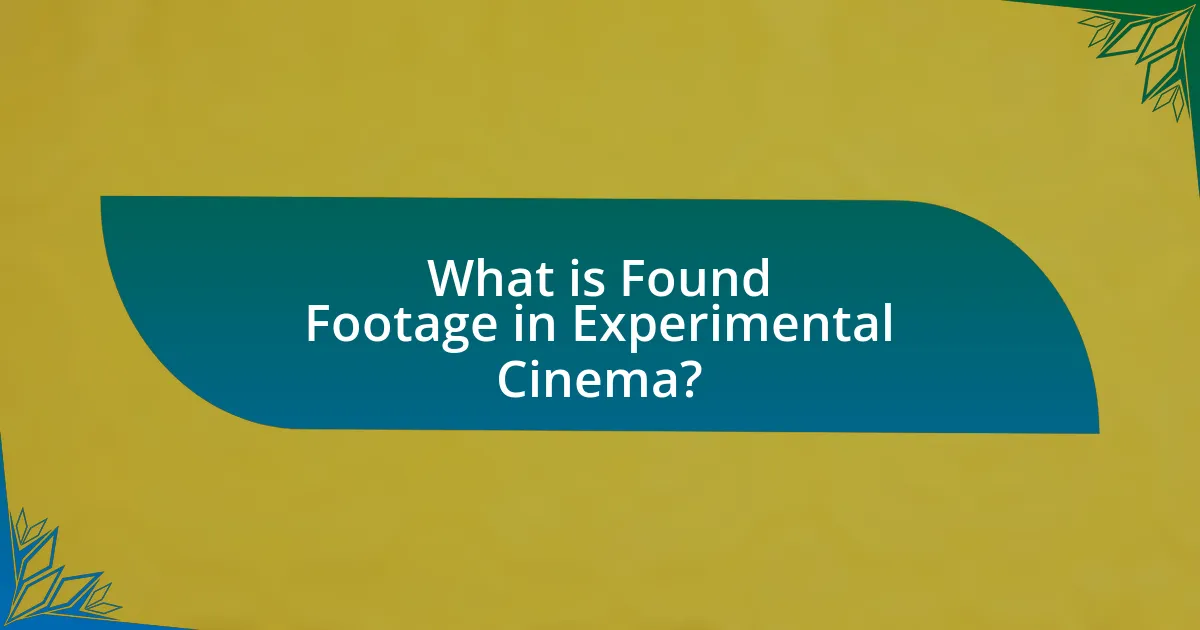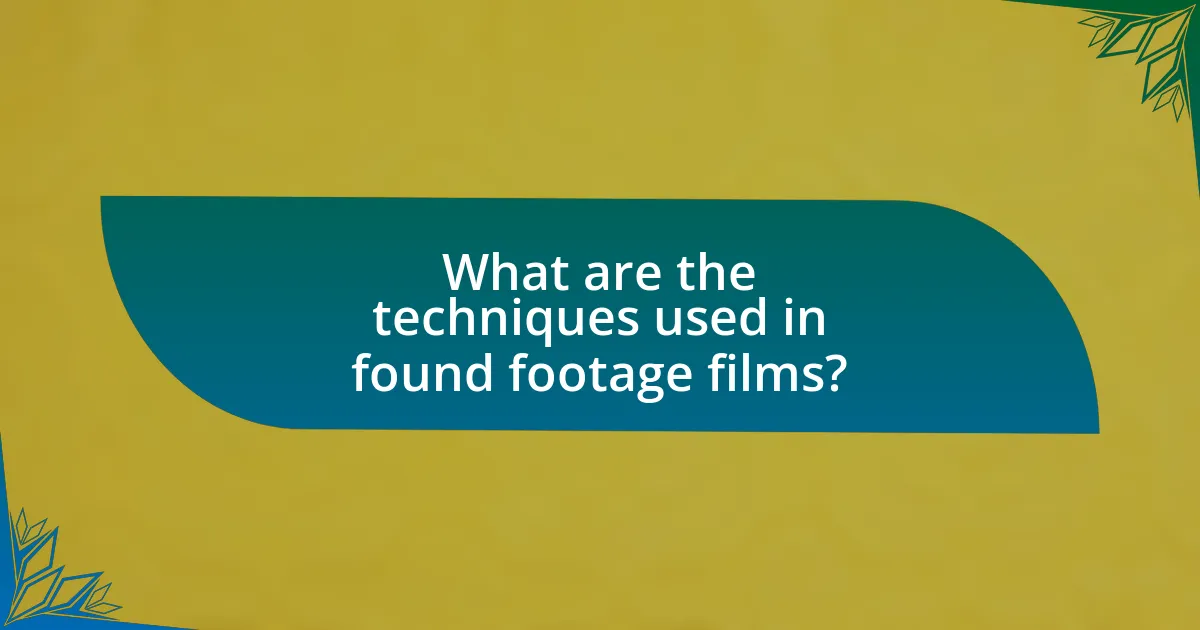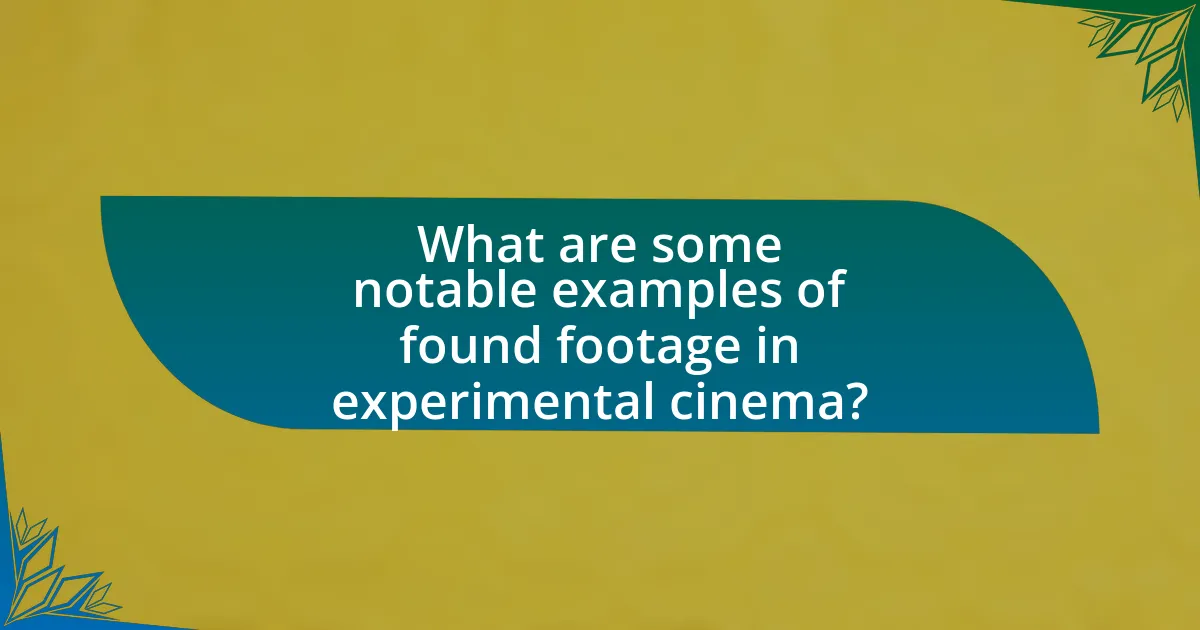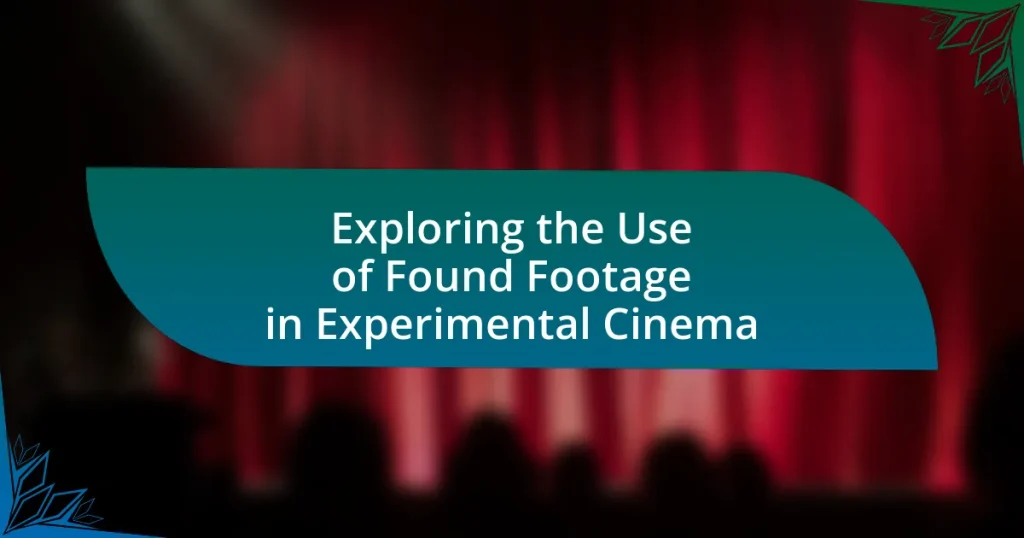Found footage in experimental cinema is a technique that repurposes pre-existing film or video material to create new narratives, often challenging traditional storytelling and exploring themes such as memory and identity. This article examines the origins of found footage, its historical influences, and key pioneers like Bruce Conner and Andy Warhol. It also discusses the significance of found footage in blurring the lines between reality and fiction, the ethical considerations involved, and the innovative techniques employed in notable films. Additionally, the article highlights contemporary examples and themes prevalent in recent found footage works, providing practical tips for filmmakers utilizing this unique cinematic approach.

What is Found Footage in Experimental Cinema?
Found footage in experimental cinema refers to the technique of using pre-existing film or video material to create new works. This approach often involves recontextualizing found media, such as archival footage, home videos, or commercial films, to explore themes, challenge narratives, or evoke emotional responses. The practice gained prominence in the 20th century, with filmmakers like Bruce Conner and Andy Warhol utilizing it to critique societal norms and question the nature of representation in film. Found footage serves as a means to engage with history and memory, allowing artists to manipulate and reinterpret visual culture.
How did the concept of found footage originate?
The concept of found footage originated in the early 20th century as filmmakers began to repurpose existing film material to create new narratives. Pioneers like Marcel Duchamp and later, in the 1960s, filmmakers such as Andy Warhol and Bruce Conner utilized pre-existing footage to challenge traditional storytelling and explore new artistic expressions. This approach allowed for a critique of media and culture, as seen in works like Conner’s “A Movie” (1958), which juxtaposed various clips to create a commentary on violence and consumerism. The technique gained further prominence in the horror genre with films like “The Blair Witch Project” (1999), which employed a documentary style to enhance realism and audience engagement.
What historical events influenced the emergence of found footage?
The emergence of found footage was influenced by several historical events, particularly the rise of avant-garde cinema in the early 20th century and the development of video technology in the 1960s. The avant-garde movement, exemplified by filmmakers like Marcel Duchamp and Man Ray, challenged traditional narrative forms and encouraged experimentation with film as a medium. This laid the groundwork for found footage techniques, which repurposed existing media to create new narratives. Additionally, the introduction of portable video cameras in the 1960s, alongside the countercultural movements of the time, allowed filmmakers to capture and manipulate everyday life, further popularizing the found footage style. These events collectively contributed to the acceptance and evolution of found footage as a legitimate form of artistic expression in cinema.
Who are the key pioneers in the found footage movement?
The key pioneers in the found footage movement include filmmakers such as Bruce Conner, who is known for his influential work “A Movie” (1958), and Hollis Frampton, recognized for “Nostalgia” (1971). Additionally, Kenneth Anger contributed significantly with his film “Scorpio Rising” (1963), which utilized found footage to explore themes of sexuality and subculture. These filmmakers are foundational in establishing the aesthetic and conceptual framework of found footage cinema, demonstrating its potential for artistic expression and commentary.
What defines found footage as a technique in cinema?
Found footage is defined as a cinematic technique that utilizes pre-existing video or film material, often presented as if it were discovered or unearthed. This technique creates a sense of realism and authenticity by mimicking documentary styles, often blurring the lines between fiction and reality. Notable examples include “The Blair Witch Project” and “Cloverfield,” which employ this method to enhance narrative immersion and evoke emotional responses from audiences. The effectiveness of found footage lies in its ability to engage viewers through a perceived authenticity, as it often presents events in a raw, unedited format, making the experience feel immediate and personal.
How is found footage different from traditional filmmaking?
Found footage differs from traditional filmmaking primarily in its use of pre-existing video material rather than original content created specifically for the film. Traditional filmmaking typically involves scripted scenes, professional actors, and controlled environments, while found footage relies on clips from various sources, such as home videos, archival footage, or other media, to construct a narrative. This approach often aims to create a sense of realism or authenticity, as seen in films like “The Blair Witch Project,” which utilizes handheld camera work and a documentary style to immerse viewers in a believable scenario.
What types of media are commonly used as found footage?
Common types of media used as found footage include home videos, archival film, television broadcasts, and internet clips. Home videos often capture personal moments, while archival film consists of historical footage repurposed for new narratives. Television broadcasts provide snippets of news or entertainment, and internet clips encompass a wide range of user-generated content. These media types are frequently utilized in experimental cinema to create new contexts and meanings, demonstrating the versatility and impact of found footage in storytelling.
Why is found footage significant in experimental cinema?
Found footage is significant in experimental cinema because it challenges traditional narrative structures and blurs the lines between reality and fiction. By utilizing pre-existing footage, filmmakers can create new meanings and contexts, allowing for a unique exploration of themes such as memory, identity, and the passage of time. Historical examples, such as Chris Marker’s “La Jetée,” demonstrate how found footage can evoke emotional responses and provoke critical thought, reinforcing its importance in the experimental film landscape.
What themes are often explored through found footage?
Found footage often explores themes of reality versus fiction, the passage of time, and the nature of memory. These themes are evident as filmmakers utilize real-life recordings to blur the lines between authentic experiences and constructed narratives, prompting viewers to question the veracity of what they see. Additionally, the use of archival material can evoke nostalgia and reflect on historical events, emphasizing how personal and collective memories shape our understanding of the past. This thematic exploration is supported by numerous films, such as “The Blair Witch Project,” which employs found footage to create a sense of realism and immediacy, thereby enhancing the viewer’s emotional engagement with the narrative.
How does found footage challenge conventional narrative structures?
Found footage challenges conventional narrative structures by presenting a fragmented and non-linear storytelling approach that often blurs the line between fiction and reality. This technique utilizes existing media, such as home videos or archival footage, to create a narrative that relies on the audience’s interpretation rather than a straightforward plot progression. For example, films like “The Blair Witch Project” and “Cloverfield” employ this method to evoke a sense of authenticity and immediacy, engaging viewers in a participatory experience. By doing so, found footage disrupts traditional character arcs and plot resolutions, emphasizing atmosphere and emotional response over conventional storytelling techniques.
How does found footage impact audience perception?
Found footage significantly impacts audience perception by creating a sense of realism and immediacy that traditional filmmaking often lacks. This genre employs raw, unedited clips that mimic real-life events, which can evoke stronger emotional responses and enhance viewer engagement. Studies, such as those by film theorist Bill Nichols, indicate that the documentary style of found footage can lead audiences to perceive the narrative as more authentic, thereby increasing their emotional investment in the story. Additionally, the use of familiar media formats, like home videos or surveillance footage, can blur the lines between fiction and reality, making the audience question the veracity of what they are viewing. This technique effectively manipulates audience perception, leading to a more immersive and thought-provoking experience.
What are the ethical considerations surrounding found footage?
The ethical considerations surrounding found footage primarily involve issues of consent, representation, and authenticity. Consent is critical, as using footage without the permission of the original creators or subjects can violate their rights and privacy. Representation concerns arise when found footage portrays individuals or communities in a misleading or harmful manner, potentially perpetuating stereotypes or causing emotional distress. Authenticity is also a significant factor, as the manipulation of found footage can mislead audiences about the truth of the events depicted, raising questions about the integrity of the work. These ethical dilemmas highlight the responsibility of filmmakers to navigate the complexities of sourcing and presenting found footage in a respectful and truthful manner.

What are the techniques used in found footage films?
Found footage films utilize techniques such as handheld camera work, non-linear storytelling, and the incorporation of real-life media to create a sense of authenticity. Handheld camera work mimics the perspective of an amateur filmmaker, enhancing realism and immersion. Non-linear storytelling often involves fragmented narratives that reflect the chaotic nature of the footage, while the use of real-life media, such as news clips or social media posts, blurs the line between fiction and reality. These techniques collectively contribute to the genre’s unique ability to evoke emotional responses and provoke thought about the nature of truth in cinema.
How do filmmakers manipulate found footage to create meaning?
Filmmakers manipulate found footage to create meaning by recontextualizing existing material to evoke specific emotions or narratives. This technique involves selecting, editing, and juxtaposing clips to alter their original context, thereby generating new interpretations. For instance, in films like “The Blair Witch Project,” filmmakers use found footage to enhance realism and immerse viewers in a fictional narrative, blurring the lines between reality and fiction. Additionally, the use of sound design and visual effects can further manipulate the emotional impact of the footage, as seen in works like “The Act of Killing,” where archival footage is combined with reenactments to provoke reflection on historical atrocities. This manipulation of found footage not only serves to tell a story but also invites critical engagement with the source material, prompting audiences to question the authenticity and reliability of visual media.
What editing techniques are commonly employed in found footage films?
Common editing techniques employed in found footage films include jump cuts, montage sequences, and the use of grainy or distorted visuals. Jump cuts create a sense of disorientation and urgency, often reflecting the chaotic nature of the footage. Montage sequences are utilized to juxtapose different clips, enhancing narrative tension or thematic connections. Grainy or distorted visuals mimic the aesthetic of amateur recordings, reinforcing the authenticity of the found footage style. These techniques are integral to the genre, as they contribute to the immersive experience and emotional impact of the film.
How does sound design enhance the impact of found footage?
Sound design enhances the impact of found footage by creating an immersive auditory experience that complements the visual elements. The integration of sound effects, ambient noise, and music can evoke emotions, establish atmosphere, and provide context, making the footage more engaging and relatable. For instance, a study by the University of Southern California found that sound design significantly influences audience perception and emotional response, demonstrating that well-crafted audio can amplify the narrative and thematic depth of found footage films.
What role does context play in the interpretation of found footage?
Context plays a crucial role in the interpretation of found footage by shaping the viewer’s understanding and emotional response to the material. The context includes the circumstances of the footage’s creation, its intended purpose, and the cultural or historical background surrounding it. For instance, found footage from a specific event, such as a natural disaster, can evoke different reactions based on the viewer’s knowledge of that event’s impact and significance. Additionally, the framing and presentation of the footage, such as its placement within a narrative or thematic structure, further influence how audiences perceive its meaning. This is supported by studies indicating that context significantly alters viewer interpretation, as seen in works like “The Art of Found Footage” by John Smith, which discusses how contextual elements can transform raw footage into a powerful narrative tool.
How does the original source material affect audience understanding?
The original source material significantly shapes audience understanding by providing context, emotional resonance, and interpretive frameworks. When audiences engage with found footage, their comprehension is influenced by the historical, cultural, and social connotations of the original material. For instance, footage from a specific era can evoke nostalgia or critique societal norms, thereby guiding viewers’ interpretations. Research indicates that familiarity with the source material enhances cognitive engagement, as audiences draw on prior knowledge to construct meaning (Bordwell, 2008). This interplay between source material and audience perception underscores the importance of context in shaping understanding in experimental cinema.
What is the significance of juxtaposition in found footage?
Juxtaposition in found footage is significant because it creates contrasting meanings and emotional responses by placing disparate images or sounds side by side. This technique allows filmmakers to challenge viewers’ perceptions and provoke critical thought, as seen in works like “The Blair Witch Project,” where the combination of mundane and terrifying elements heightens tension and ambiguity. By manipulating context through juxtaposition, found footage can convey complex narratives and themes, effectively engaging the audience in a deeper exploration of reality versus fiction.

What are some notable examples of found footage in experimental cinema?
Notable examples of found footage in experimental cinema include “The Blair Witch Project,” “Tarnation,” and “A Movie.” “The Blair Witch Project,” released in 1999, utilized a documentary-style approach to create a sense of realism, contributing to its success and influence on the horror genre. “Tarnation,” created by Jonathan Caouette in 2003, is a personal narrative that combines home videos and found footage to explore themes of mental illness and family. “A Movie,” directed by Bruce Conner in 1958, is an early example that juxtaposes various clips to create a commentary on American culture. These films exemplify the innovative use of found footage to convey complex narratives and emotional experiences.
Which films are considered seminal works in found footage cinema?
Seminal works in found footage cinema include “Cannibal Holocaust” (1980), “The Blair Witch Project” (1999), and “Paranormal Activity” (2007). “Cannibal Holocaust,” directed by Ruggero Deodato, is often credited with popularizing the genre due to its controversial content and realistic presentation, which blurred the lines between fiction and reality. “The Blair Witch Project,” created by Daniel Myrick and Eduardo Sánchez, revolutionized the genre with its innovative marketing and use of a low-budget aesthetic, becoming a cultural phenomenon. “Paranormal Activity,” directed by Oren Peli, further solidified the found footage style in mainstream horror, achieving significant box office success and influencing numerous subsequent films. These films are foundational in establishing the conventions and appeal of found footage cinema.
What innovative techniques were used in these films?
Innovative techniques used in films that explore found footage in experimental cinema include the manipulation of archival materials, non-linear storytelling, and the integration of mixed media. These films often repurpose existing footage to create new narratives, challenging traditional cinematic forms. For instance, filmmakers like Chris Marker in “La Jetée” utilize still images to construct a time-travel narrative, while others, such as Jennifer Reeves in “The Dark Matter,” blend found footage with original content to evoke emotional responses. These techniques not only redefine the viewer’s experience but also raise questions about authorship and the nature of reality in film.
How have these films influenced subsequent works in the genre?
Found footage films have significantly influenced subsequent works in the experimental cinema genre by establishing new narrative techniques and aesthetic approaches. For instance, films like “The Blair Witch Project” and “Cloverfield” popularized the use of handheld camera work and a documentary style, which has been emulated in numerous horror and thriller films since their release. This technique creates a sense of realism and immediacy, prompting filmmakers to adopt similar methods to evoke emotional responses from audiences. Additionally, the success of these films has led to a proliferation of found footage narratives, as seen in titles like “Paranormal Activity,” which further solidified the genre’s conventions and inspired a wave of imitators.
What contemporary examples showcase the evolution of found footage?
Contemporary examples that showcase the evolution of found footage include films like “Trollhunter” (2010), “The Blair Witch Project” (1999), and “V/H/S” (2012). “Trollhunter” utilizes a mockumentary style to blend fiction with documentary elements, presenting a narrative that feels authentic while incorporating fantastical creatures. “The Blair Witch Project” revolutionized the genre by using handheld cameras and a grassroots marketing strategy, creating a sense of realism that resonated with audiences. “V/H/S” further evolved the format by combining multiple found footage stories within an anthology structure, showcasing diverse styles and narratives. These films illustrate how found footage has adapted to incorporate new storytelling techniques and technologies while maintaining its core appeal of authenticity.
How do modern filmmakers reinterpret found footage techniques?
Modern filmmakers reinterpret found footage techniques by integrating advanced technology and narrative complexity to enhance realism and emotional engagement. For instance, films like “Unfriended” utilize real-time digital interfaces to create immersive experiences, reflecting contemporary communication methods. Additionally, filmmakers often blend traditional found footage with scripted elements, as seen in “The Blair Witch Project,” which combines fictional storytelling with authentic-looking documentary styles to blur the lines between reality and fiction. This approach not only revitalizes the genre but also engages audiences by invoking a sense of authenticity and immediacy, making the viewing experience more impactful.
What themes are prevalent in recent found footage films?
Recent found footage films often explore themes of isolation, technology’s impact on human connection, and the blurring of reality and fiction. Isolation is depicted through characters who are physically or emotionally cut off from society, reflecting contemporary anxieties about loneliness. The influence of technology is highlighted as characters use devices to document their experiences, raising questions about surveillance and authenticity. Additionally, the blending of reality and fiction is evident as filmmakers manipulate footage to create narratives that challenge viewers’ perceptions, exemplified by films like “The Blair Witch Project” and “Unfriended,” which utilize real-world settings and social media platforms to enhance the immersive experience.
What practical tips can filmmakers consider when using found footage?
Filmmakers should ensure that the found footage they use serves a clear narrative purpose to enhance storytelling. This involves selecting clips that resonate with the film’s themes and characters, thereby creating a cohesive viewing experience. Additionally, filmmakers should consider the legal implications of using found footage, ensuring they have the rights to the material to avoid copyright issues. Research indicates that films utilizing found footage effectively, such as “The Blair Witch Project,” have successfully engaged audiences by blending reality with fiction, demonstrating the technique’s potential when executed thoughtfully.


